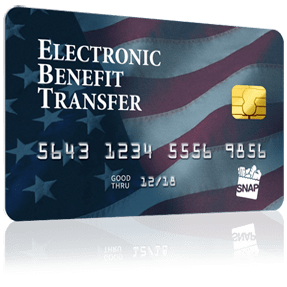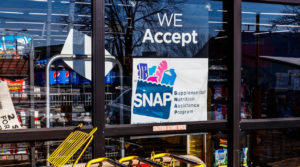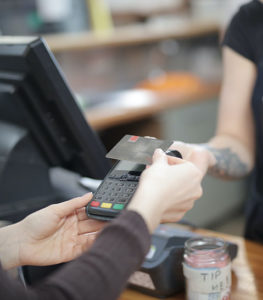
by Grace Barone
It has become increasingly difficult for people living at or below the poverty line to maintain a normal quality of life. Inflation, job uncertainty, the housing market. We're seeing an increased number of people in need of assistance. More and more people are looking into government assistance for help with basic needs. The topics of EBT, RMP, and SNAP programs have been at the forefront of both business owners' and consumers minds. More people are trying to figure out how to receive this assistance or how to help provide for these recipients. In this blog, we will go over everything a retailer needs to know about becoming certified to accept EBT at their business.
What is EBT?
To provide government benefits to qualified people and families, the United States uses a system known as EBT or Electronic Benefit Transfer. It is a system that delivers benefits electronically in place of the conventional paper-based food stamp system. Not every food item is eligible for purchase with EBT. Fruits, vegetables, meats, dairy products, bread, and cereals are just a few examples of eligible foods that can be purchased with EBT benefits. We'll go into more specifics on stocking requirements for EBT retailers later. EBT normally cannot be used to purchase non-food products including alcohol, tobacco, pet food, vitamins, and hot cooked foods.
SNAP
Supplemental Nutrition Assistance Program (SNAP) benefits, formerly known as food stamps, are predominantly distributed through EBT. SNAP is a federal aid program that gives money to qualified low-income people and families so they can buy food. Using a specific debit card that may be used at approved shops, such as grocery stores, supermarkets, and farmers' markets, the EBT system enables users to receive their benefits. This card is usually referred to as a Link card.
RMP
This is the abbreviation for the Restaurant Meal Program. This is when a restaurant can accept EBT for the prepared meals they serve. As explained earlier, typically EBT can not be used for hot cooked foods. This is for people who may not have stable housing or a consistent way to cook food. Not every state allows RMP. Currently, the only states that have this program in place are California, Arizona, Maryland, Rhode Island, Michigan and Virginia. Because of this, restaurants need to go through a different application process to be able to participate in RMP.
What is the Difference Between EBT and SNAP?
They're often used interchangeably, but EBT and SNAP are technically not the same.
SNAP helps participating individuals purchase food. The program used to be called food stamps, which were paper coupons used to purchase food at qualifying retailers years ago. The individual can then use their EBT card to purchase goods. The benefit for customers is that they can use a card like the majority of buyers who are purchasing items outright. If they happen to be at a store that accepts EBT payments, they can conveniently use their EBT card.
Benefits of Government Meal Assistance
EBT, SNAP, and RMP are incredibly important programs. These government assistance programs provide many benefits to people in need of help;
Food Insecurity
EBT benefits help combat food insecurity by ensuring that eligible individuals and families have access to an adequate and nutritious diet. It helps address the challenge of limited financial resources and allows recipients to purchase essential food items.
Health and Well-Being
In order to maintain general health and well-being, one must consume enough food. Low-income people and families can purchase nourishing foods including fruits, vegetables, lean proteins, and whole grains with the help of EBT support. It assists in lowering the danger of diet-related health issues like obesity, chronic diseases, and malnutrition.
Vulnerable Populations
For vulnerable groups including children, the elderly, and people with disabilities, EBT programs are especially crucial. These groups could experience higher rates of poverty and have fewer resources available to them to achieve their fundamental requirements. Their access to food and nutrition is ensured by the safety net that EBT assistance provides.
Economic Stimulus
Benefits from EBT may boost the local economy. When recipients utilize their benefits to buy food, it helps the neighborhood's small businesses, supermarkets, and farmers' markets. In turn, this promotes economic growth and employment creation.
Poverty Alleviation
EBT assistance is a useful tool for eliminating poverty and rescuing people and families from difficult situations. It frees up other scarce resources for other necessities like housing, healthcare, education, and utilities by giving money for food.
Social Equality and Inclusion
By guaranteeing that people and families from all backgrounds, regardless of their socioeconomic situation, have access to basic requirements, EBT programs seek to promote social equality. It lessens inequalities in access to food and nutrition and promotes the development of a more inclusive society.
Long Term Benefits
Beyond just providing food right away, EBT assistance can have long-term advantages. By ensuring that people, especially children, have access to a healthy diet, we can improve people's health, cognitive development, educational success, and opportunities for the future.
EBT Retailer Benefits
But beyond the benefit to the customer, there are many benefits to becoming an EBT/SNAP retailer. You'll have to be approved and accepted into the U.S. Department of Agriculture's Food and Nutrition Service (USDA FNS). Once you're accepted you'll be able to install EBT and SNAP processing equipment that will enable you to accept food stamps at the point of sale. Retailers who have an EBT license and are authorized to accept EBT payments are eligible for several advantages. The following are some benefits for retailers using the EBT program:
Expanded Customer Base
Accepting EBT payments allows retailers to tap into a broader customer base. EBT recipients include low-income individuals and families who rely on government assistance to purchase food. By accepting EBT, retailers can attract and serve this customer segment, potentially increasing their sales and customer loyalty. Accepting EBT payments allows retailers to actively engage with their local community and contribute to food accessibility.
Increased Sales Revenue
EBT payments can help retailers generate more money from sales. SNAP payments give participants money that is designated just for buying food. Retailers can take advantage of some of these perks by taking EBT, potentially increasing transaction volume and overall sales.
Competitive Advantage
Retailers may have a competitive edge over establishments that do not accept EBT payments by taking part in the EBT program. Retailers may stand out from the competition and possibly draw customers who prefer to utilize their benefits at approved locations by providing a payment option that is tailored to SNAP participants.
Reimbursement for Authorized Purchases
Retailers who accept EBT payments may be reimbursed for the qualified food items that SNAP participants have purchased. Usually, the state agency in charge of overseeing the EBT program reimburses the monies. In addition to ensuring that businesses are paid for the goods they sell to SNAP beneficiaries, this reimbursement can assist cover the expenses related to taking EBT.
Access to Government Support
Participating retailers have access to services and help offered by government organizations. To assist retailers comply with program requirements, maintain accurate records, and correctly process EBT transactions, these resources may include training programs, educational materials, and technical assistance.
Stocking Requirements
Before going through the application process, you should first make sure you meet the stocking requirements to be eligible for EBT acceptance. Here is a full page that outlines the specific stocking requirements. But here's a brief run down of what you need to know. As a retailer, you will either be accepted by meeting one of two lists of criteria.
Criterion A
These are the criteria that most retailers meet. To meet these requirements, the retailer must continuously have 36 specific items in stock. You need 3 stocking units of 3 staple food varieties in each of the 4 staple food categories. On top of that, it's also required that a store has 3 stocking units of 1 perishable staple food variety in at least 2 staple food categories. That is a little wordy and could be hard to understand.
The 4 staple food categories are; Dairy, Fruits and Vegetable, Meat (red meat, poultry or fish), and Bread/Cereals. So you need to have 3 different options of each category, and at least 3 units of each. For example, to meet the requirements of the Meat category, you can offer chicken, beef, and fish. This would cover the 3 different varieties. Then you need to make sure you have at least 3 units of each. So 3 cans of tuna, 3 packs of beef jerky, and 3 packs of chicken breasts. Some retailers make the mistake of not having different varieties. For example, having 100% apple juice and apple sauce will not count as 2 separate varieties, because they are both apples.
Criterion B
This is for specialty stores that receive 50% of their total gross revenue from staple foods. For example, a store that only sells fresh seafood and nothing else, may qualify under criterion B since the main item they sell falls under a staple food category.
Becoming an EBT Retailer: The Application
It's the FNS that accepts qualified stores and retailers into the program. You won't be able to accept EBT payments unless you are admitted after an approval process. Certain partners, such as the experts here at Velocity Merchant Services, can help you before, during, and after the application process, allowing you to focus more on your business rather than the technicalities of the EBT retailer application process.
However, even if you've been admitted as an EBT/SNAP retailer, you must follow the rules to maintain your standing. If you fail to follow the program rules, you will no longer be able to accept SNAP or EBT transactions. You might just get a warning, but repeat offenders can be disqualified from accepting EBT payments altogether.
While more retailers are interested in accepting alternative payments such as EBT, the EBT retailer application process has indeed become more complicated over the years. Even those that have accepted EBT payments for years are having to adhere to more difficult requirements to maintain their EBT standing -- such as specific inventory and revenue requirements -- but it all starts with the application. If you can avoid issues with your application, you'll be able to implement your grocery EBT processing equipment sooner rather than later, and that can be a boom to your business.
1. Documents
A typical EBT application starts with gathering your documents. An EBT license requires that you're either already open and conducting business or that you're within 10 days of buying or opening a store that will serve EBT customers. If your store is already open and operating, you'll need to share certain documents such as:
- Your business' tax return for the previous year
- Social security cards
- Driver's licenses for each owner, member, manager, or partner in the business
- Copy of each business license
- Lottery license, alcohol license, and tobacco license that your store has obtained
It is important to note that going through VMS for assistance with applying for your EBT license allows for some wiggle room. For example, you may not need to provide your businesses tax returns and some documents may be supplemented for others. The EBT specialists make sure your application is submitted correctly. Government jargon can be difficult to understand and the process for applying for an EBT license must be done in a timely manner. Having assistance will increase your chances of being accepted.
2. Register for a USDA Account
After you've gathered all your documentation, you'll have to register for a USDA account online. A USDA eAuthentication account can be obtained via their web application process. Simply follow the instructions and register for an account. Once your account has been registered, activate your account according to the email process. Activating your USDA account will enable you to apply for becoming an EBT retailer via the SNAP application. That said, if you own 10 or more stores, you'll have to apply as a multi-store owner or MSO.
3. Provide Necessary Documents
When you start your application, you'll have 30 days to complete it. This includes supplying the necessary information and submitting the completed application. If you manage not to complete your application within 30 days, it'll be deleted and you'll have to start over. So it's important to complete your EBT retailer application within the time allotted. Note that you'll need the names, addresses, and social security numbers for each store owner and manager. You will also need sales information for the store in question as you work your way through the application.
Once you've submitted the required information, you may also have to submit additional information to complete your application. You may receive communication through email or regular mail with instructions on how to submit this additional information, but it's also visible at the end of your application, so don't assume that you're done with the application when you reach the end.
After submitting the completed application and all necessary documentation, you can check your application status directly with the FNS. Once you sign in you'll be able to see the status of your application. If any additional information is needed, you'll be contacted by the FNS. If you have any questions about your application, you can also call the SNAP Retailer Service Center at 1-877-823-4369.
4. Confirmation of Stocking Requirements
After the proper documentation is submitted and the application is completed. The USDA will have a certified employee go out to your physical business and confirm that you have the proper socking requirements. It is important to be honest about your inventory during the application process. If the official visits your business and sees that you do not have the 36 required inventory items, your business will not be approved to accept EBT. If everything checks out, the retailer will be approved to accept EBT. It's also important to consistently maintain this stock, it's not uncommon for USDA personnel to pop into a store at random to make sure the requirements are being maintained. For the RMP the USDA does say restaurants are subject to inspection but this is not as common.
EBT Point-of-Sale Equipment
After a business has been approved to accept EBT, the next thing that needs to happen is obtaining the right POS system to actually be able to receive EBT payments. In the past, retailers would need an entirely separate machine that was dedicated to EBT only. The machines were costly and outdated. Luckily there are different options for retailers now. At VMS we have all-in-one machines that accept all forms of payment including food stamps.
Additional Information About Our EBT Processing Equipment
The EBT point-of-sale equipment we send to retailers is securely encrypted with PCI software that accepts all forms of payments. This includes credit cards, debit cards, chip cards, contactless payments as well as EBT payments. As a retailer, you can use your processing equipment to charge for all types of transactions, not just EBT payments. That means you can save even more money on the other types of transactions that take place in your business. This can significantly increase your bottom line.
With our EBT processing equipment, you'll meet all the needs of the USDA FNS, including accepting PIN transactions, using encryption keys, and communicating your seven-digit FNS account number along with each valid transaction. While you may be able to reprogram your existing processing equipment to meet the new demands of EBT payments, any mistake could hold up all your payments or put your entire account in jeopardy. It's also much easier and quicker -- and many times cheaper -- to simply upgrade your equipment and keep on moving forward than trying to make that old and outdated equipment work.
Don't forget that if your existing point-of-sale device isn't compatible with EBT payments, you'll need a separate device anyway. That could cost you extra in fees, not to mention the complication of managing two sets of devices -- one for EBT payments and another for everything else. Aside from possibly paying more per transaction and various hidden fees, that can directly impact your profits. But with new EBT point-of-sale equipment, you won't have to pay any extra fees aside from transaction processing.
After Your EBT Processing Equipment Arrives
Once your EBT point of sale equipment has been installed, you'll be able to offer EBT payments to any of your customers. That's in addition to processing many other types of payments, including credit and debit payments. Not only will that help you build a customer base, but both existing and future customers won't be limited based on the types of payments that you can accept. Customers will be able to use their SNAP benefits in your place of business, as well as their credit and debit cards, helping your business grow and helping your ability to meet the needs of your customers.
With an EBT point of sale reader from VMS, you'll be making all your future transactions swift and secure via the state-of-the-art technology baked in, and that can make running your business easier from a payment collection standpoint. For over 25 years, we've helped businesses obtain the payment processing equipment that they need to continue to conduct business, and we can bring the same reliable service to your EBT transactions as the rest of all your transactions.
How Retailers Can Lose Their License
If retailers taking part in the EBT don't follow the rules and regulations of the program, they risk losing their license. The following are some typical causes for a retailer to lose their EBT license:
Violation of Program Rules
Retailers must follow the specific program rules and guidelines set by the state agency responsible for administering the EBT program. Violations of these rules, such as unauthorized use of EBT cards, fraudulent activities, or selling non-eligible items, can result in the revocation of an EBT license.
Failure to Maintain Eligibility
For retailers to take part in the EBT program, they must continually meet qualifying conditions. This can entail keeping a current company license, adhering to health and safety requirements, maintaining stocking requirements, and other pertinent local and state laws. A retailer's EBT license may be revoked if they don't comply with certain rules.
Issues with compliance
Retailers are expected to follow the guidelines for recording and reporting EBT transactions. They must preserve transaction records, correctly report sales, and comply with any audits or investigations the state agency conducts. An EBT license may be revoked for failing to meet certain reporting and documentation requirements.
Suspension or Disqualification from Other Programs
If a retailer is suspended or disqualified from other government assistance programs, such as SNAP, they may also lose their EBT license. This can occur if a retailer is found to have engaged in fraudulent activities, violated program rules, or failed to meet program requirements in another assistance program.
Noncompliance with POS System Requirements
Retailers are obliged to use approved Point of Sale (POS) systems for processing EBT transactions. Noncompliance with POS System Requirements is prohibited. A retailer's EBT license may be revoked if they don't employ an approved POS system or break certain rules pertaining to EBT processing.
Failure to Maintain Authorized Retailer Status
By adhering to continuing compliance standards and meeting program requirements, retailers must actively maintain their authorized retailer position. A retailer's EBT license could be withdrawn if they don't renew their authorization, send in the necessary documentation, or maintain their information current.
Maintaining EBT License
Each state may have different procedures and penalties for losing an EBT license. Depending on the situation and the state's rules, a retailer who has their EBT license in jeopardy may be able to file an official appeal or correct the error.
It is crucial for retailers taking part in the EBT program to get familiar with the rules of the program, maintain compliance with all specifications, and quickly fix any problems or issues brought up by the state organization in charge of running the program.
Becoming a Licensed EBT Retailer
If you want to learn more about how you can become a certified EBT retailer visit getvms.com, fill out the form below, or call us at 888-902-6227. We will make the lengthy and sometimes confusing process much easier, bettering your chances of getting approved quickly. Our EBT specialists will help you from start to finish with your businesses application. We will also help set you up with the correct POS machine to start accepting EBT payments.







